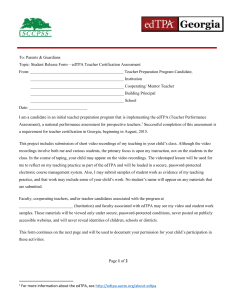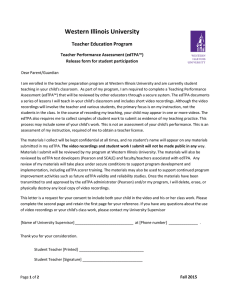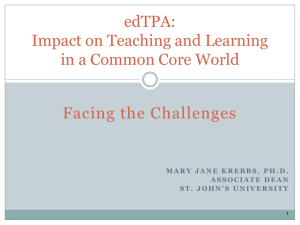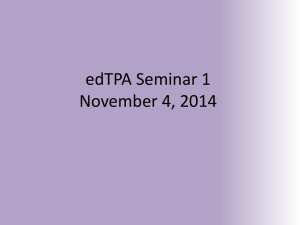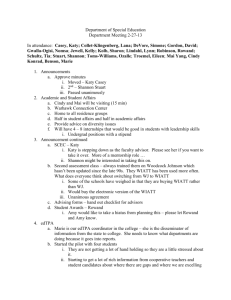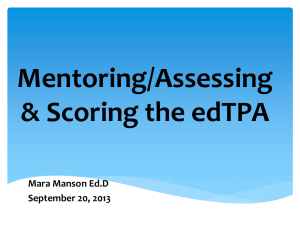Video recordings are included in the Teacher Performance Assessment (edTPA)... context and richness to the evaluation of your teaching. However,... edTPA Video Recording and Resource Requirements for Wisconsin Teacher Candidates
advertisement
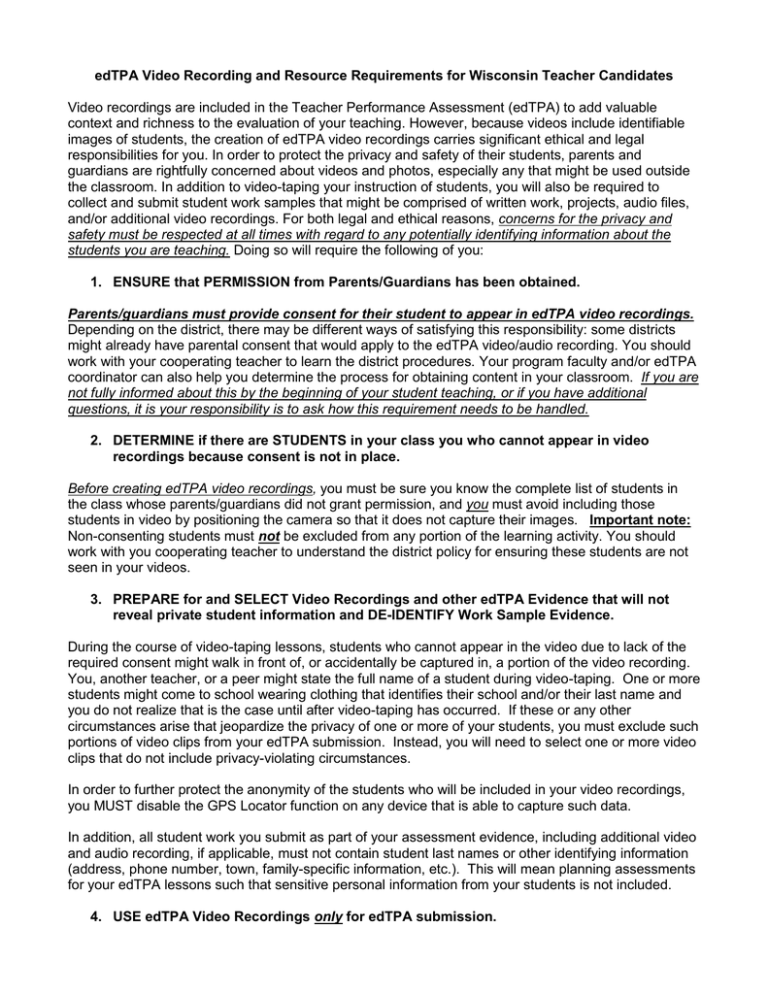
edTPA Video Recording and Resource Requirements for Wisconsin Teacher Candidates Video recordings are included in the Teacher Performance Assessment (edTPA) to add valuable context and richness to the evaluation of your teaching. However, because videos include identifiable images of students, the creation of edTPA video recordings carries significant ethical and legal responsibilities for you. In order to protect the privacy and safety of their students, parents and guardians are rightfully concerned about videos and photos, especially any that might be used outside the classroom. In addition to video-taping your instruction of students, you will also be required to collect and submit student work samples that might be comprised of written work, projects, audio files, and/or additional video recordings. For both legal and ethical reasons, concerns for the privacy and safety must be respected at all times with regard to any potentially identifying information about the students you are teaching. Doing so will require the following of you: 1. ENSURE that PERMISSION from Parents/Guardians has been obtained. Parents/guardians must provide consent for their student to appear in edTPA video recordings. Depending on the district, there may be different ways of satisfying this responsibility: some districts might already have parental consent that would apply to the edTPA video/audio recording. You should work with your cooperating teacher to learn the district procedures. Your program faculty and/or edTPA coordinator can also help you determine the process for obtaining content in your classroom. If you are not fully informed about this by the beginning of your student teaching, or if you have additional questions, it is your responsibility is to ask how this requirement needs to be handled. 2. DETERMINE if there are STUDENTS in your class you who cannot appear in video recordings because consent is not in place. Before creating edTPA video recordings, you must be sure you know the complete list of students in the class whose parents/guardians did not grant permission, and you must avoid including those students in video by positioning the camera so that it does not capture their images. Important note: Non-consenting students must not be excluded from any portion of the learning activity. You should work with you cooperating teacher to understand the district policy for ensuring these students are not seen in your videos. 3. PREPARE for and SELECT Video Recordings and other edTPA Evidence that will not reveal private student information and DE-IDENTIFY Work Sample Evidence. During the course of video-taping lessons, students who cannot appear in the video due to lack of the required consent might walk in front of, or accidentally be captured in, a portion of the video recording. You, another teacher, or a peer might state the full name of a student during video-taping. One or more students might come to school wearing clothing that identifies their school and/or their last name and you do not realize that is the case until after video-taping has occurred. If these or any other circumstances arise that jeopardize the privacy of one or more of your students, you must exclude such portions of video clips from your edTPA submission. Instead, you will need to select one or more video clips that do not include privacy-violating circumstances. In order to further protect the anonymity of the students who will be included in your video recordings, you MUST disable the GPS Locator function on any device that is able to capture such data. In addition, all student work you submit as part of your assessment evidence, including additional video and audio recording, if applicable, must not contain student last names or other identifying information (address, phone number, town, family-specific information, etc.). This will mean planning assessments for your edTPA lessons such that sensitive personal information from your students is not included. 4. USE edTPA Video Recordings only for edTPA submission. No portion of video recordings created as part of your evidence for edTPA submission (whether or not included with your submission) can be used for any other personal or professional purpose. In particular, video containing images of your students must not be posted online, sent to friends and family, or included in your job portfolio. Your preparation program may seek your explicit, written consent to share the video with them, as part of your completed edTPA portfolio, for purposes of program improvement, provided consent for this activity was included in the consent form signed by parents/guardians. *Anyone suspected of misusing video clips (s) will be reported to your college/university and will be held accountable for any sanctions imposed by your college/university. This violation falls under the FERPA laws and are subject to an investigation. Other possible civil and criminal investigations and/or penalties can apply. (Remember: Once you have shared the video electronically with anyone, you have effectively lost control of it.) 5. DESTROY Video Recordings after confirmation of successful edTPA completion. Once you have received your scores from Pearson and received confirmation from your program that you have successfully completed the edTPA, all video footage obtained in relation to the edTPA must be destroyed. This includes the segments submitted and all video material created as part of your effort to prepare for and complete the edTPA. Destruction of video means removal from all devices (cameras, iPads, phones, computers, jump drives, etc.) you used to record and store video images. 6. Use and reproduction The edTPA resources that you are receiving electronic access to and will be using as part of your edTPA are and always remain the exclusive property of Stanford’s Center for Learning, Assessment, and Equity (SCALE). You have no right to reproduce in any manner, shape or form any of the edTPA resources that you have been granted access to as part of this assessment. The foregoing includes, but is not limited to the following: reproducing, in whole or in part, a hard copy of any edTPA resource; electronically sharing, in whole or in part, any edTPA resource; posting on any internet site, the whole or part of any edTPA resource. You may not loan or give any edTPA resources to any person, corporation, or entity not associated with your college/university. These resources include, but are not limited to all documents, training videos, edTPA Assessment Handbooks, and Commentary templates. I have read the above requirements and agree to follow them in order to protect the confidentiality of my students to the best of my ability during the completion of the edTPA. Name (printed)_____________________________________________ Signature_________________________________________________ Permanent Address: __________________________________________ _________________________________________________________ Date_________________

